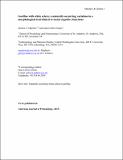Files in this item
Gorillas with white sclera : a naturally occurring variation in a morphological trait linked to social cognitive functions
Item metadata
| dc.contributor.author | Mayhew, Jessica | |
| dc.contributor.author | Gomez, Juan-Carlos | |
| dc.date.accessioned | 2016-04-05T23:01:22Z | |
| dc.date.available | 2016-04-05T23:01:22Z | |
| dc.date.issued | 2015-07-28 | |
| dc.identifier | 175351100 | |
| dc.identifier | 3e6be2b3-9db4-4b41-becd-c40b05f5477a | |
| dc.identifier | 84937977431 | |
| dc.identifier | 000358678900005 | |
| dc.identifier.citation | Mayhew , J & Gomez , J-C 2015 , ' Gorillas with white sclera : a naturally occurring variation in a morphological trait linked to social cognitive functions ' , American Journal of Primatology , vol. 77 , no. 8 , pp. 869-877 . https://doi.org/10.1002/ajp.22411 | en |
| dc.identifier.issn | 0275-2565 | |
| dc.identifier.other | ORCID: /0000-0002-0218-9834/work/64361106 | |
| dc.identifier.uri | https://hdl.handle.net/10023/8562 | |
| dc.description | Funding: Self-funded PhD. | en |
| dc.description.abstract | Human eye morphology is considered unique among the primates in that humans possess larger width/height ratios (WHR), expose a greater amount of visible sclera (SSI; width of exposed eyeball/width of visible iris), and critically, have a white sclera due to a lack of pigmentation. White sclera in humans amplifies gaze direction, whereas the all-dark eyes of apes are hypothesized to conceal gaze from others. This study examines WHR and SSI in humans (N = 13) and gorillas (N = 85) engaged in direct and averted gazes and introduces a qualitative assessment of sclera color to evaluate variations in sclera pigmentation. The results confirm previous findings that humans possess a larger WHR than gorillas but indicate that humans and gorillas display similar amounts of visible sclera. Additionally, 72% (N = 124) of gorilla eyes in this sample deviated from the assumed all-dark eye condition. This questions whether gaze-camouflage is the primary function of darkened sclera in non-human primates or whether other functional roles can be ascribed to the sclera, light or dark. We argue that white sclera evolved to amplify direct gazes in humans, which would have played a significant role in the development of ostensive communication, which is communication that both shows something and shows the intention to show something. We conclude that the horizontal elongation of the human eye, rather than sclera color, more reliably distinguishes human from great ape eyes, represented here by gorillas. | |
| dc.format.extent | 1177414 | |
| dc.language.iso | eng | |
| dc.relation.ispartof | American Journal of Primatology | en |
| dc.subject | White sclera | en |
| dc.subject | Gaze camouflaging | en |
| dc.subject | Gorillas | en |
| dc.subject | Eye morphology | en |
| dc.subject | Gaze following | en |
| dc.subject | RC0321 Neuroscience. Biological psychiatry. Neuropsychiatry | en |
| dc.subject | BF Psychology | en |
| dc.subject | NDAS | en |
| dc.subject | BDC | en |
| dc.subject.lcc | RC0321 | en |
| dc.subject.lcc | BF | en |
| dc.title | Gorillas with white sclera : a naturally occurring variation in a morphological trait linked to social cognitive functions | en |
| dc.type | Journal article | en |
| dc.contributor.institution | University of St Andrews. School of Psychology and Neuroscience | en |
| dc.contributor.institution | University of St Andrews. Institute of Behavioural and Neural Sciences | en |
| dc.contributor.institution | University of St Andrews. Centre for Social Learning & Cognitive Evolution | en |
| dc.identifier.doi | 10.1002/ajp.22411 | |
| dc.description.status | Peer reviewed | en |
| dc.date.embargoedUntil | 2016-04-06 |
This item appears in the following Collection(s)
Items in the St Andrews Research Repository are protected by copyright, with all rights reserved, unless otherwise indicated.

